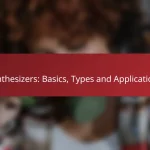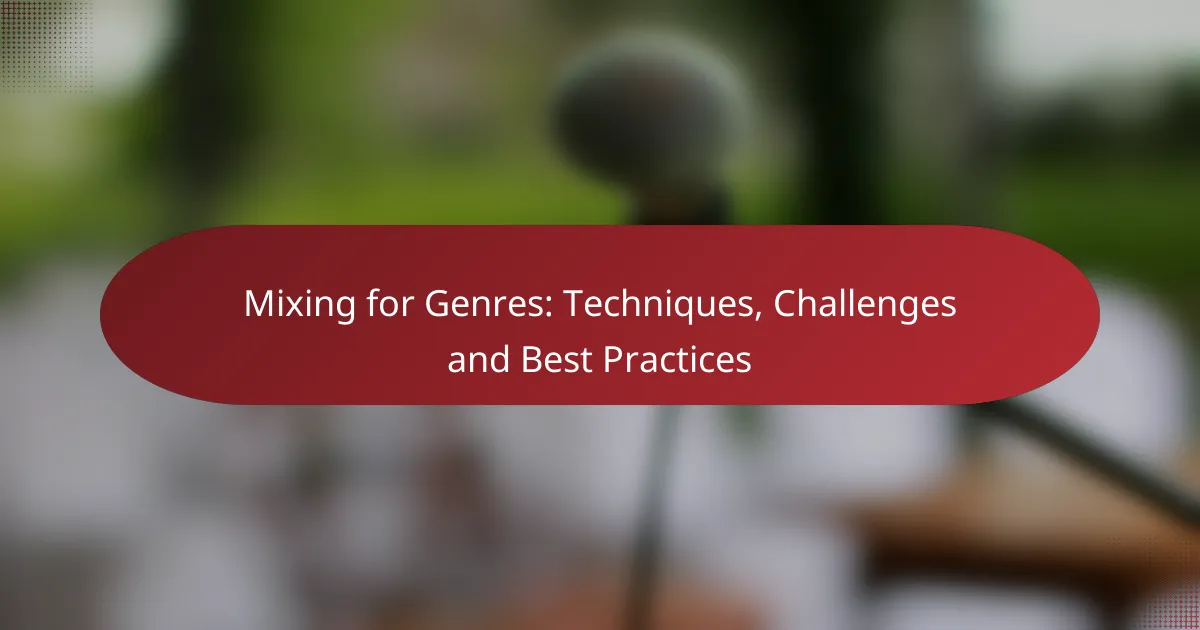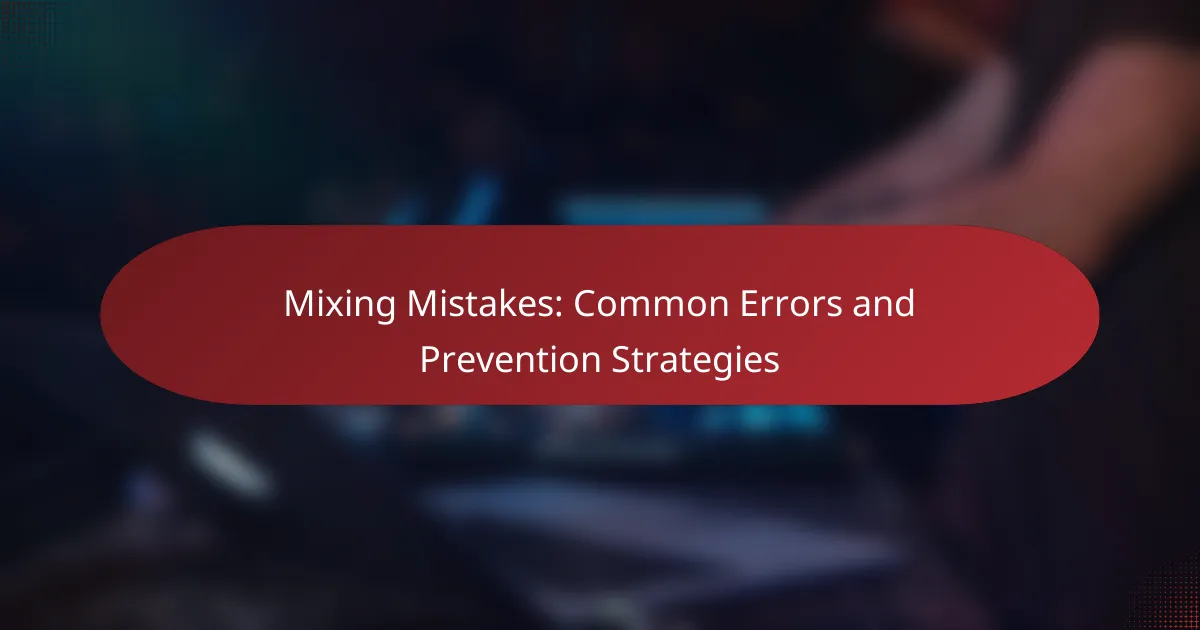Mixing techniques are essential for enhancing your tracks and achieving a polished sound. Key methods such as equalization, compression, reverb, panning, and automation each contribute to creating a balanced mix that captivates listeners. By mastering these techniques, you can ensure clarity and depth in your music, allowing every element to shine through effectively.
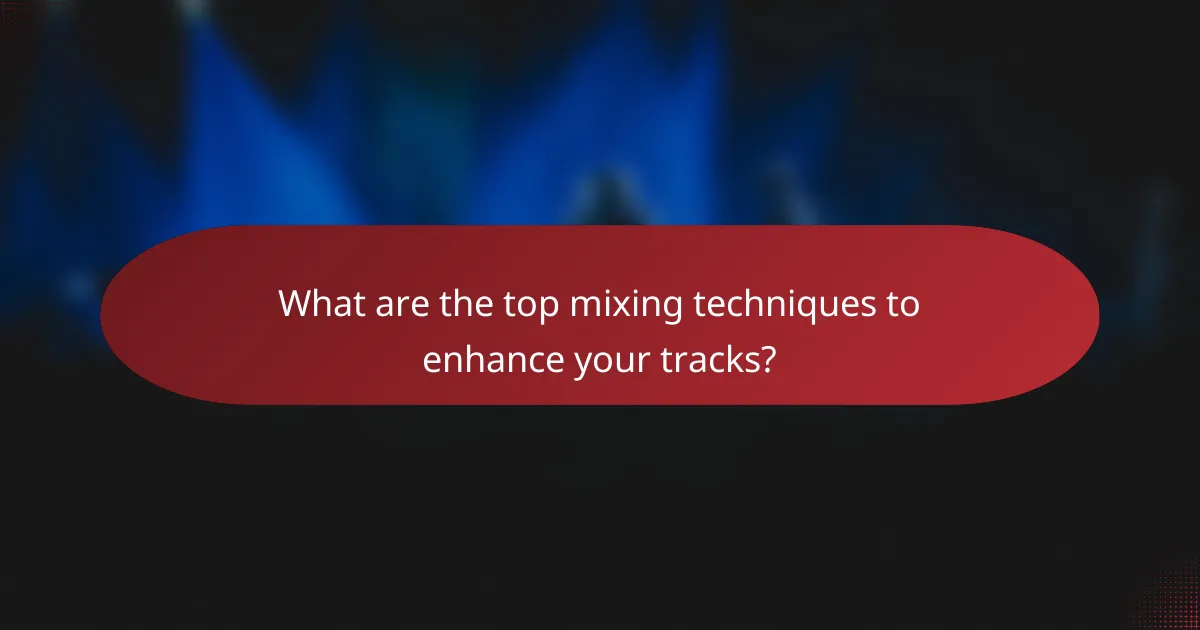
What are the top mixing techniques to enhance your tracks?
The top mixing techniques to enhance your tracks include equalization, compression, reverb, panning, and automation. Each method plays a crucial role in shaping the sound, ensuring clarity, and creating a balanced mix that resonates with listeners.
Equalization (EQ)
Equalization, or EQ, is the process of adjusting the balance between frequency components of an audio signal. By boosting or cutting specific frequencies, you can enhance clarity and remove unwanted muddiness in your mix. For example, cutting low frequencies on vocals can help them sit better in the mix without clashing with bass instruments.
When using EQ, consider the frequency ranges: low (20-250 Hz), mid (250 Hz-4 kHz), and high (4 kHz-20 kHz). A common practice is to use a high-pass filter on tracks that don’t require low-end presence, which can free up space for bass and kick drums.
Compression
Compression controls the dynamic range of your audio, making quiet sounds louder and loud sounds quieter. This technique helps maintain a consistent level throughout the track, ensuring that no elements are lost in the mix. A good starting point is to set a ratio of 3:1 or 4:1 for vocals and instruments.
Be cautious with the attack and release settings; a fast attack can tame peaks, while a slower release allows for a more natural sound. Over-compression can lead to a lifeless mix, so aim for a balance that retains the energy of the performance.
Reverb
Reverb adds a sense of space and depth to your tracks by simulating the natural reflections of sound in an environment. It can make a mix feel more cohesive and polished. Use reverb sparingly; too much can muddy the mix and obscure details.
When applying reverb, consider the size of the space you want to emulate. Shorter reverb times work well for tighter mixes, while longer times can create a more atmospheric feel. Experiment with different types of reverb, such as plate or hall, to find the best fit for your sound.
Panning
Panning involves placing audio signals within the stereo field, creating a sense of width and separation. By strategically positioning elements, you can enhance clarity and prevent frequencies from clashing. For instance, panning guitars slightly left and right can create a fuller sound without overwhelming the mix.
A common practice is to keep bass and kick drums centered, while other instruments can be spread across the stereo field. This approach helps maintain a balanced mix and allows listeners to experience a more immersive sound.
Automation
Automation allows you to control various parameters of your mix over time, such as volume, panning, and effects. This technique can add dynamics and interest to your tracks, making them more engaging. For example, you might automate a vocal’s volume to emphasize certain phrases or adjust reverb levels during different sections.
When using automation, keep it subtle to avoid overwhelming the listener. Small adjustments can make a significant impact, so focus on enhancing the emotional flow of the track without drawing attention away from the music itself.

How does equalization improve track clarity?
Equalization enhances track clarity by adjusting the balance of different frequency components in audio. By emphasizing or reducing specific frequencies, you can achieve a cleaner, more defined sound that allows each element in a mix to be heard distinctly.
Removes unwanted frequencies
Equalization allows you to identify and eliminate unwanted frequencies that can muddy a mix. For instance, cutting low frequencies from vocals or instruments can prevent overlapping sounds, creating a clearer overall sound. A common practice is to use a high-pass filter to remove frequencies below a certain threshold, typically around 80 Hz for vocals.
When applying EQ, be cautious not to overdo it. Excessive cuts can lead to a hollow sound, so aim for subtle adjustments, often in the range of 3-6 dB. Regularly A/B test your adjustments to ensure the mix remains balanced.
Enhances vocal presence
Equalization can significantly enhance vocal presence by boosting frequencies that contribute to clarity and intelligibility. Typically, emphasizing frequencies between 3 kHz and 5 kHz can make vocals stand out in a mix. This range is crucial for articulation and helps listeners understand the lyrics better.
To achieve optimal vocal presence, consider using a slight boost of around 2-4 dB in the mid-range frequencies while simultaneously cutting any harshness in the upper mid-range. This technique can help the vocals shine without overpowering other elements in the track.

What is the role of compression in mixing?
Compression in mixing is a technique used to control the dynamic range of audio signals, making quieter sounds louder and louder sounds quieter. This process enhances the overall balance and clarity of a mix, allowing individual elements to sit well together without overwhelming each other.
Controls dynamic range
Compression effectively reduces the difference between the loudest and quietest parts of a track, known as dynamic range. By applying compression, you can ensure that all elements are audible, especially in dense mixes where certain sounds may get lost. A common approach is to set a ratio between 2:1 and 4:1 for moderate compression, which can help maintain a natural sound while controlling peaks.
When using compression, pay attention to the attack and release settings. A fast attack time can catch transients, while a slower release allows the sound to breathe. Experimenting with these settings can help you find the right balance for each track.
Adds punch to instruments
Compression can add punch to instruments, making them sound more impactful in a mix. By emphasizing the attack of a sound, compression can bring out the percussive elements, giving instruments like drums and guitars a more defined presence. A typical setting for achieving punch might involve a fast attack and a medium release, allowing the initial hit to stand out while maintaining sustain.
To enhance punch, consider using parallel compression, where you blend a heavily compressed version of a track with the original. This technique retains the dynamic qualities of the original while adding the desired impact, making it particularly effective for drums and bass.
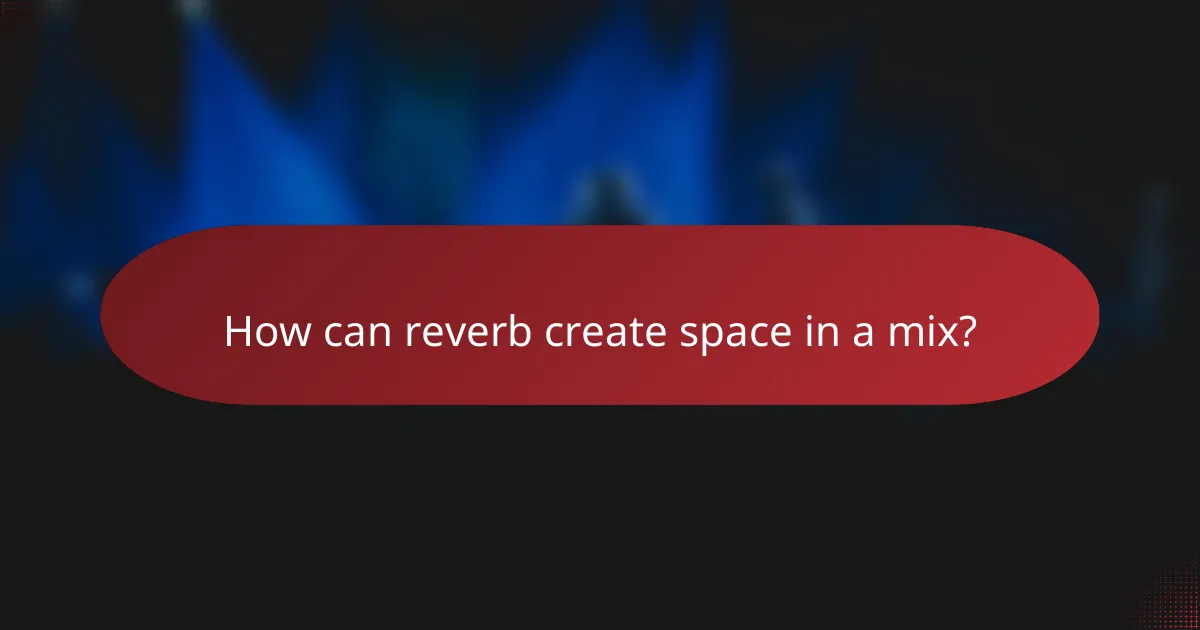
How can reverb create space in a mix?
Reverb creates space in a mix by simulating the natural reflections of sound in an environment, adding depth and dimension to audio tracks. By incorporating reverb, you can enhance the perception of distance and atmosphere, making individual elements feel more cohesive within the overall soundscape.
Adds depth to vocals
Using reverb on vocals can significantly enhance their presence in a mix. A well-applied reverb can make vocals sound fuller and more immersive, helping them blend seamlessly with other instruments. Aim for a reverb time of around 1-2 seconds for most vocal tracks, adjusting based on the genre and desired effect.
Be cautious not to overdo it; excessive reverb can muddy the clarity of the vocals. A good practice is to use a dry/wet mix ratio of about 20-30% for vocals, allowing the natural sound to shine through while still benefiting from the spatial effect.
Simulates acoustic environments
Reverb can effectively simulate various acoustic environments, from small rooms to large halls. By selecting different reverb types, such as plate, hall, or room, you can create the illusion of space that matches the mood of your track. For instance, a large hall reverb can evoke a sense of grandeur, while a small room reverb can provide intimacy.
When choosing a reverb type, consider the instrumentation and the emotional tone of the piece. Experimenting with parameters like pre-delay and decay time can help tailor the reverb to fit the specific acoustic environment you wish to replicate, enhancing the overall listening experience.

What are effective panning techniques?
Effective panning techniques involve strategically placing sounds in the stereo field to create a more immersive listening experience. By manipulating the left and right channels, you can enhance the clarity and separation of instruments in your mix.
Creates stereo width
Panning is essential for creating stereo width, which gives the listener a sense of space and dimension. By placing sounds at various points across the stereo field, you can make a track feel wider and more engaging. For example, you might pan rhythm guitars slightly left and lead guitars slightly right to achieve a balanced sound.
Consider using extreme panning for certain elements, like percussion or effects, to add interest and depth. However, avoid overdoing it, as excessive panning can lead to a disjointed mix. A good rule of thumb is to keep the main elements, like vocals and bass, closer to the center while spreading supporting instruments across the field.
Balances instrument placement
Effective panning helps balance instrument placement, ensuring that no single element overwhelms the mix. By distributing sounds across the stereo field, you can create a more cohesive sound that allows each instrument to shine. For instance, if you have a full drum kit, panning the hi-hats slightly to one side and the snare slightly to the other can create a more natural feel.
When balancing instruments, consider the frequency range of each sound. Low-frequency instruments, such as bass and kick drums, typically benefit from being centered, while higher-frequency instruments can be panned to create separation. This approach helps maintain clarity and prevents muddiness in the mix.

How does automation enhance mixing precision?
Automation enhances mixing precision by allowing sound engineers to control various parameters over time, ensuring that levels and effects are applied exactly where needed. This technique enables a more dynamic and polished final mix, making it easier to achieve a professional sound.
Adjusts levels dynamically
Dynamic level adjustments through automation allow for precise control of volume changes throughout a track. For instance, you can raise the vocal level during a chorus while lowering it during verses, creating a more engaging listening experience. This technique can help prevent muddiness in the mix and ensure that each element is heard clearly.
When using automation for levels, consider the overall balance of your mix. Aim for gradual changes rather than abrupt shifts, as these can disrupt the flow of the music. A good rule of thumb is to keep volume changes within a range of 1-3 dB for subtle adjustments, while larger shifts can be used for dramatic effect.
Shapes sound over time
Automation can also shape sound over time by controlling effects such as reverb, delay, and EQ. For example, you might automate a reverb effect to gradually increase during a build-up, enhancing the emotional impact of the climax. This technique adds depth and interest to your mix, making it feel more dynamic and alive.
When automating effects, be mindful of how they interact with other elements in your mix. Overusing automation can lead to a cluttered sound, so focus on key moments where these changes will have the most impact. Experiment with different automation curves, such as linear or exponential, to find the best fit for your track’s style and mood.
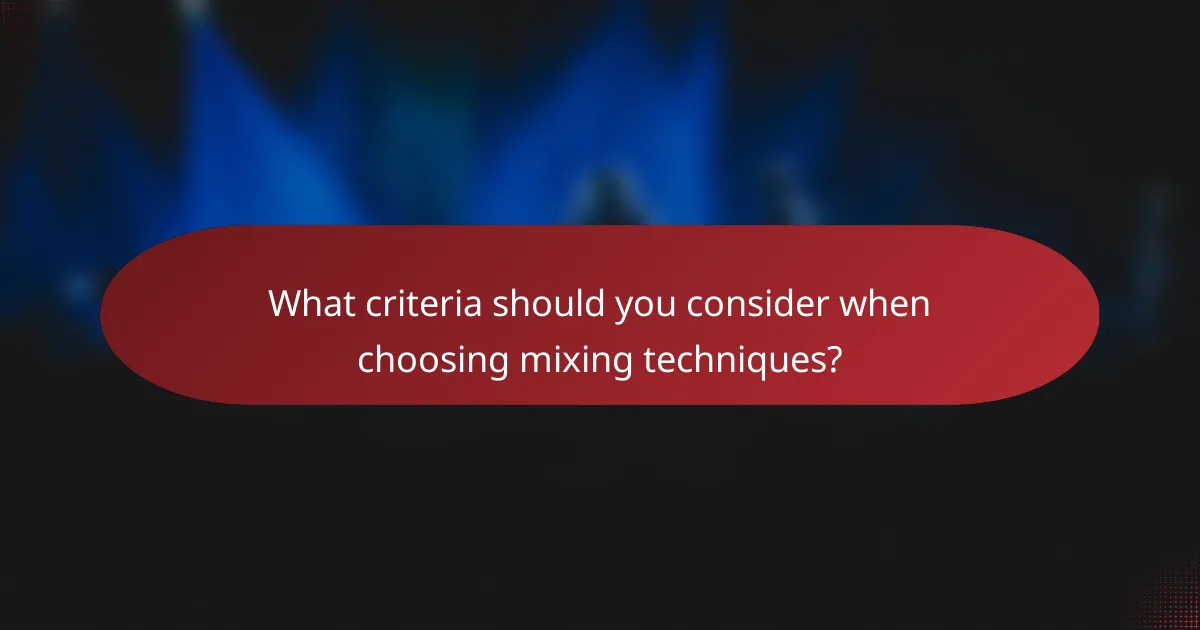
What criteria should you consider when choosing mixing techniques?
When selecting mixing techniques, consider the genre of your track, the instruments involved, and the desired emotional impact. Each technique can significantly alter the sound and clarity of your mix, so understanding their strengths and weaknesses is crucial.
Equalization (EQ)
Equalization is a fundamental mixing technique that adjusts the balance of frequency components in your audio. By boosting or cutting specific frequency ranges, you can enhance clarity and prevent muddiness in your mix. For example, cutting low frequencies on vocals can help them sit better in the mix without competing with bass instruments.
When using EQ, aim for subtle adjustments, typically within a range of 3-6 dB, to avoid unnatural sound. A common pitfall is over-EQing, which can lead to a harsh or unbalanced mix. Use a spectrum analyzer to visualize frequency distribution and make informed decisions.
Compression
Compression controls the dynamic range of your audio, making quiet sounds louder and loud sounds quieter. This technique helps maintain a consistent volume level throughout your track, which is especially important for vocals and bass. A good starting point is to apply a ratio of 3:1 to 5:1 for vocals, adjusting the threshold to achieve desired results.
Be cautious not to over-compress, as this can lead to a lifeless sound. Aim for a gain reduction of around 3-5 dB for a natural feel. Experiment with attack and release times to shape the character of the sound; faster settings can add punch, while slower settings can create a smoother effect.
Reverb
Reverb adds a sense of space and depth to your mix, simulating the natural reflections of sound in an environment. It can help blend elements together, making them feel cohesive. Use reverb sparingly, typically on vocals and snare drums, to avoid overwhelming the mix.
Consider the type of reverb you choose, such as plate, hall, or room, as each imparts a different character. A good rule of thumb is to set the reverb time between 1-2 seconds for vocals, adjusting the wet/dry mix to maintain clarity. Too much reverb can create a muddy sound, so always listen critically.
Panning
Panning involves placing audio elements across the stereo field to create a sense of width and separation. By strategically positioning instruments and vocals, you can enhance the listening experience and prevent clutter. A common approach is to pan rhythm guitars slightly left and right, while keeping the lead vocals centered.
Use panning to guide the listener’s attention and create a balanced mix. Avoid extreme panning, which can lead to an unbalanced sound. A good practice is to keep the low-frequency elements, like kick drums and bass, centered to maintain a solid foundation.
Automation
Automation allows you to dynamically change volume, panning, effects, and other parameters over time, adding movement and interest to your mix. This technique is particularly useful for creating build-ups and drops in electronic music or emphasizing certain phrases in a vocal performance.
To effectively use automation, identify sections of your track that could benefit from dynamic changes. For instance, gradually increasing the volume of a guitar solo can create a more impactful moment. Be mindful not to overdo it; subtle changes often yield the best results.




